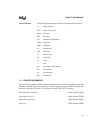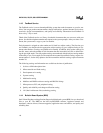
1-3
GUIDE TO THIS MANUAL
Appendix B, “Signal Descriptions” — describes the function(s) of each device pin. Descrip-
tions are listed alphabetically by signal name. This appendix also provides a list of the signals
grouped by functional category.
Appendix C, “Registers” — accumulates, for convenient reference, copies of the register defi-
nition figures that appear throughout the manual.
A glossary has been included for your convenience.
1.2 NOTATIONAL CONVENTIONS AND TERMINOLOGY
The following notations and terminology are used in this manual. The Glossary defines other
terms with special meanings.
# The pound symbol (#) has either of two meanings, depending on the
context. When used with a signal name, the symbol means that the
signal is active low. When used in an instruction, the symbol prefixes
an immediate value in immediate addressing mode.
italics Italics identify variables and introduce new terminology. The context
in which italics are used distinguishes between the two possible
meanings.
Variables in registers and signal names are commonly represented by
x and y, where x represents the first variable and y represents the
second variable. For example, in register Px.y, x represents the
variable [1–4] that identifies the specific port, and y represents the
register bit variable [7:0]. Variables must be replaced with the correct
values when configuring or programming registers or identifying
signals.
XXXX Uppercase X (no italics) represents an unknown value or a “don’t
care” state or condition. The value may be either binary or
hexadecimal, depending on the context. For example, 2XAFH (hex)
indicates that bits 11:8 are unknown; 10XX in binary context
indicates that the two LSBs are unknown.
Assert and Deassert The terms assert and deassert refer to the act of making a signal
active (enabled) and inactive (disabled), respectively. The active
polarity (high/low) is defined by the signal name. Active-low signals
are designated by a pound symbol (#) suffix; active-high signals have
no suffix. To assert RD# is to drive it low; to assert ALE is to drive it
high; to deassert RD# is to drive it high; to deassert ALE is to drive it
low.


















